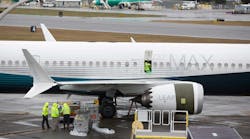Boeing Co.’s directors are sharpening their focus on safety after the 737 Max’s grounding ends, forming a new oversight panel and recommending changes to the planemaker’s structure and design practices after two crashes that killed 346 people.
The board’s new Aerospace Safety Committee will supervise the development and manufacturing of Boeing aircraft, the company said in a statement Wednesday. Retired Admiral Edmund Giambastiani, a former vice chairman of the U.S. Joint Chiefs of Staff, is leading the group.
The organizational revamp is intended to protect employees who flag issues from intimidation from managers, while providing greater transparency for senior executives and directors, Giambastiani said in an interview. Dennis Muilenburg, Boeing’s chief executive officer, has already begun implementing some of the proposals made following a five-month internal review, Giambastiani said.
“He has not wasted time in doing this. And he has clearly, as the chairman, not put any restrictions on us. We had full control,” said Giambastiani, who spearheaded the examination of the company’s airplane design policies and processes. “Dennis has the board’s confidence.”
The safety announcement comes at a pivotal moment for Boeing as it fine tunes software for the Max, which has been grounded for more than six months. The company, which is seeking to allay public outrage over the tragedies and regain consumer trust, also faces numerous reports and investigations in the weeks ahead that are likely to criticize lapses involving a flight system linked to the crashes.
A final report by Indonesian investigators examining the Oct. 29 crash of a Lion Air 737 Max is due in November. In the U.S., the National Transportation Safety Board is preparing safety recommendations, Congress is planning hearings and several independent panels are reviewing various aspects of the cases. The Justice Department is conducting a criminal investigation.
Boeing climbed 1.5% to $387.27 at 1:57 pm. in New York.
Tarnished Reputation
The manufacturer’s reputation has been badly tarnished after its marquee 737 Max jets fell from the sky twice within five months, prompting global regulators in March to ban flights.
According to preliminary accident reports on the Lion Air disaster and an Ethiopian Airlines crash in March, pilots were overwhelmed by an obscure new flight-control feature added to the Max: the Maneuvering Augmentation Characteristics System. MCAS kicked on because of erroneous sensor readings and repeatedly pushed down the noses of the planes.
Giambastiani declined to discuss if flaws were missed during the Max development process, saying the board committee wasn’t assigned to delve into the accidents, but rather to focus on company policies and procedures.
Its review “has found that the 737 Max was certified for service following successful completion of the FAA’s standard, extensive and comprehensive certification process and protocols,” he said. “Further, our committee found no competing requirements in the safety certification of the Max that would in any way have compromised the safeness of the Max.”
Enhancing Safety
Boeing directors are updating the company’s policies and processes for airplane design and development following a five-month study. The effort was spearheaded by Giambastiani, a career nuclear submarine officer in the U.S. Navy, at Muilenburg’s request. Duke Energy Corp. CEO Lynn Good and Lawrence Kellner, the former head of Continental Airlines, will join Giambastiani on the new safety panel, which was approved by directors in August.
The board recommended that Boeing establish a product and safety organization to report to senior leadership and Giambastiani’s committee that would safeguard employees who flag safety concerns or “undue pressure” from managers.
In a switch, the Boeing engineering and technical experts who act as representatives of the U.S. Federal Aviation Administration for airplane certification would report to the new group rather than managers belonging to the aircraft program. This would alleviate some of the potential conflict for the so-called Administrative Representatives in flagging issues.
The board also recommended that Boeing:
- Change the reporting structure for engineers. Throughout the manufacturer, they would report through chief engineer Greg Hyslop to Muilenburg. The vice president heading the new product and services safety organization would also report to Hyslop.
- Require all safety reports, and potential safety reports, to be reviewed by the chief engineer. Doing so would “increase transparency” and ensure that issues flagged from all levels of the company wind up in front of senior management.
- Work with airlines to “re-examine assumptions around flight-deck design and operation,” particularly given shifts in demographics and “future pilot populations.” Boeing should also work to bolster pilot training methods and teaching materials. Flight-deck designs should be “as user-friendly as possible,” Giambastiani said.




